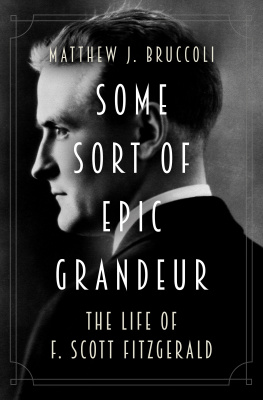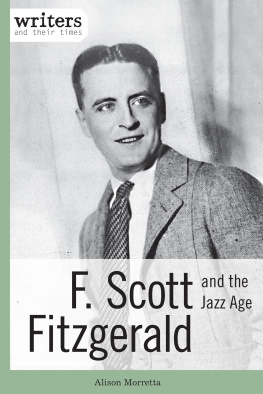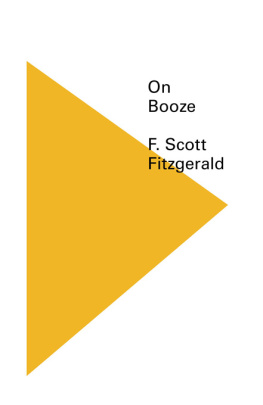The Early Short Stories of F. Scott Fitzgerald


The Early Short Stories of F. Scott Fitzgerald
F. SCOTT FITZGERALD
Edited by
James Daley

DOVER PUBLICATIONS, INC.
Mineola, New York
DOVER THRIFT EDITIONS
G ENERAL E DITOR M ARY C AROLYN W ALDREP
E DITOR O F T HIS V OLUME :J ANET B.K OPITO
Copyright
Note copyright 2015 by Dover Publications, Inc.
All rights reserved.
Bibliographical Note
The Early Short Stories of F. Scott Fitzgerald, first published by Dover Publications, Inc., in 2015, is a new anthology of short stories reprinted from standard editions. Minor typographical errors in the original sources have been corrected in the text throughout. James Daley has made the selection and provided a Note specially for this edition.
Library of Congress Cataloging-in-Publication Data
Fitzgerald, F. Scott (Francis Scott), 18961940.
[Short stories. Selections]
The early short stories of F. Scott Fitzgerald / F. Scott Fitzgerald; edited by James Daley.
p. cm. (Dover thrift editions)
eISBN-13: 978-0-486-80343-2
I. Daley, James, 1979 editor. II. Title.
PS3511.I9A6 2015
813.52dc23
2014042037
Manufactured in the United States by Courier Corporation 79465201 2015
www.doverpublications.com
Note
F RANCIS S COTT K EY Fitzgerald published his first short story in the St. Paul Academy Newspaper when he was only thirteen years old. It was a detective story, entitled The Mystery of the Raymond Mortgage, and while it certainly demonstrated the young authors promise, it was not until he enrolled at Princeton in 1913 that Fitzgerald began to take his writing seriously. At Princeton, Fitzgerald wrote numerous stories and plays, mostly for the Nassau Literary Magazine, as well as for the schools humor magazine, The Princeton Tiger. After dropping out of Princeton in 1917, Fitzgerald spent much of the next five years writing stories for publications like The Saturday Evening Post and Colliers Weekly as a means of supporting himself while he worked on his novels. Although now Fitzgerald is remembered more for his novels than his short fiction, one can easily see the seeds of his great longer works in many of these early short stories.
This collection begins with four stories from Fitzgeralds years at Princeton: Babes in the Woods, The Pierian Springs and the Last Straw, SentimentAnd the Use of Rouge, and The Spire and the Gargoyle. Written around the time of his short-lived romance with the wealthy socialite Ginevra King, which ended when her father famously told Fitzgerald that poor boys shouldnt think of marrying rich girls, the themes and characters contained in these stories clearly form the basis of This Side of Paradise.
In the immediate aftermath of his success with This Side of Paradise, Fitzgerald wrote numerous short stories about the flapper lifestyle that he and his wife Zelda had become so notably connected with. While the settings and scenes of the flapper world can be seen in most of his stories from this period, few demonstrate this lifestyle as successfully as The Camels Back and Head and Shoulders. In both of these stories we see characters falling in and out of love while frolicking, dancing, and drinking their way through the height of the Roaring Twenties.
With Dalyrimple Goes Wrong, The Four Fists, The Lees of Happiness, and The Smilers, we find four excellent examples of Fitzgeralds experimentations with a more naturalistic and somber style. Benediction and The Cut-Glass Bowl are even further removed from the lighthearted tone of Fitzgeralds flapper stories, and as such represent two of the authors most intimate and emotional stories. Exploring themes of family and faith, and marriage and infidelity, these two beautiful stories highlight Fitzgeralds ability to portray his characters deepest frailties with incredible empathy and tenderness. While there are settings and situations in each of these stories that still place them within the flapper period, their melancholy tone and serious themes place them as more direct precursors of The Beautiful and Damned.
On the other side of the coin we find Jemina, The Mountain Girl; Tarquin of Cheapside; and The Curious Case of Benjamin Buttonthree stories that exemplify the humor of Fitzgeralds early work. Both Jemina, A Mountain Girl and Tarquin of Cheapside are lighthearted stories that Fitzgerald first wrote in college and then later revised for inclusion in Tales of the Jazz Age. While The Curious Case of Benjamin Button, without a doubt one of Fitzgeralds best-loved short stories, was also included in Tales of the Jazz Age, it was first published in Colliers in May of 1922.
The last story in this collection, Winter Dreams, is widely considered to be one of Fitzgeralds most accomplished works of short fiction. Through the storys protagonist, a middle-class boy who yearns to become part of the monied elite, we see some of the first glimpses of Fitzgeralds exploration of the themes of desire and class, which he would later write about in The Great Gatsby.
From the collegiate romances that predated This Side of Paradise, to the somber tales that inspired The Beautiful and Damned, to the Gatsby-esque explorations of Winter Dreams, the stories in this collection provide an intimate window into the creative genius of F. Scott Fitzgerald. It is our hope that these stories will inspire readers to continue on with the legacy of Fitzgeralds writing with a new-found understanding of how his early work both informed and inspired some of the greatest novels ever written, from one of the greatest writers ever to live.
James Daley
Contents
The Early Short Stories of F. Scott Fitzgerald

BABES IN THE WOODS
I.
A T THE TOP of the stairs she paused. The emotions of divers on spring-boards, leading-ladies on opening nights, and lumpy, bestriped young men on the day of the Big Game, crowded through her. She felt as if she should have descended to a burst of drums or to a discordant blend of gems from Thas and Carmen. She had never been so worried about her appearance, she had never been so satisfied with it. She had been sixteen years old for two months.
Isabelle! called Elaine from her doorway.
Im ready, she caught a slight lump of nervousness in her throat.
Ive got on the wrong slippers and stockingsyoull have to wait a minute.
Isabelle started toward Elaines door for a last peek at a mirror, but something decided her to stand there and gaze down the stairs. They curved tantalizingly and she could just catch a glimpse of two pairs of masculine feet in the hall below. Pump-shod in uniform black they gave no hint of identity, but eagerly she wondered if one pair were attached to Kenneth Powers. This young man, as yet unmet, had taken up a considerable part of her daythe first day of her arrival. Going up in the machine from the station Elaine had volunteered, amid a rain of questions and comment, revelation and exaggeration














